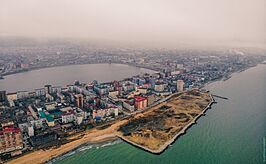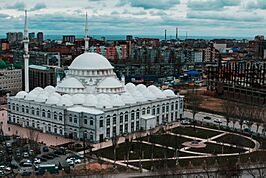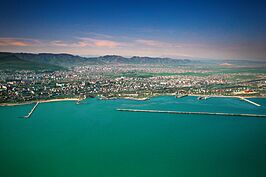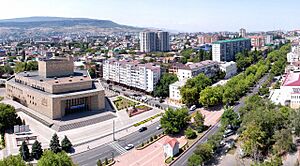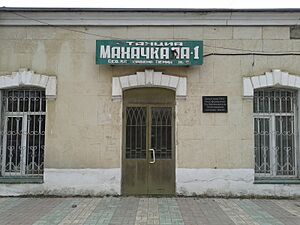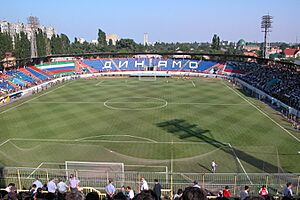Makhachkala facts for kids
Quick facts for kids Makhachkala (English)Махачкала (Russian) |
|
|---|---|
| - City - | |
| [[File:
|250px]] Top-down, left-to-right: View of Makhachkala, The Government Building of Dagestan, Makhachkala Lighthouse, Grand Mosque of Makhachkala, Caspian Sea |
|
|
|
|
| Administrative status | |
| Country | Russia |
| Federal subject | Republic of Dagestan |
| Administratively subordinated to | City of Makhachkala |
| Capital of | Republic of Dagestan |
| Municipal status | |
| Urban okrug | Makhachkala Urban Okrug |
| Head | Salman Dadaev |
| Representative body | Assembly of Deputies |
| Statistics | |
| Area | 468.13 km2 (180.75 sq mi) |
| Population (2010 Census, preliminary) |
572,076 inhabitants |
| - Rank in 2010 | 27th |
| Density | 1,222/km2 (3,165/sq mi) |
| Time zone | MSK (UTC+04:00) |
| Founded | 1844 |
| City status since | 1857 |
| Postal code(s) | 367000-367999 |
| Dialing code(s) | +7 8722 |
| Official website: http://www.mkala.ru | |
Makhachkala is a very important city in Russia. It is the capital and largest city of Dagestan. The city is located right on the coast of the Caspian Sea. It covers an area of about 468 square kilometers (181 sq mi).
More than 623,000 people live in Makhachkala. If you include the surrounding areas, the population is about 1 million. This makes it the fourth-largest city in the Caucasus region. It is also the biggest city in the North Caucasus and the third-largest city on the Caspian Sea.
Makhachkala has a very diverse population, with many different ethnic groups living there. The city was once known as Petrovskoye (from 1844 to 1857) and later Port-Petrovsk (from 1857 to 1921). Locals also called it Anji.
Today, Makhachkala is a key center for business, education, science, and culture in the North Caucasus. It is a major seaport on the Caspian Sea and an important transport hub. The city is growing very quickly, with lots of new buildings being constructed.
Contents
History of Makhachkala
Makhachkala has a long history, with roots in older towns like Tarki and Anji (also called Andzhi or Anji-kala). Some stories say that Anji-kala was a fortress of the ancient Khazar capital, Semender.
Early Influences and Name Changes
The area saw many changes over centuries. In the 8th century, Muslims arrived and spread Islam. Later, different empires like the Mongols, Golden Horde, and Ottomans took control at various times.
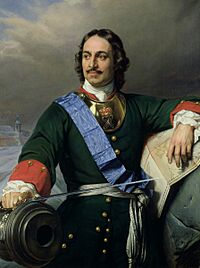
In 1722, the Russian Tsar Peter the Great visited this area. This visit was part of his Persian Campaign. Because of his visit, a fort was built here in the 1840s and named Petrovskoye.
In 1857, Petrovskoye became a city and was renamed Petrovsk-Port. The local Kumyks people still called it Anzhi-Qala. This name means "The Pearl Fortress" in the Kumyk language. There is even a hill nearby called Anji-arqa, which means "the hill of Anji."
Modern History and Development
In 1894, a railway line was built. This connected the city to Vladikavkaz and Baku, helping it grow.
During the Russian Civil War, British air forces were based in Petrovsk in 1919. They carried out bombing missions. In March 1920, the city was taken by the Red Army.
After the Russian Revolution, the city's name changed again. On May 14, 1921, Petrovsk was renamed Makhachkala. This new name honored Magomed-Ali 'Makhach' Dakhadaev, a local revolutionary. On the same day, it became the capital of the new Dagestan Autonomous Soviet Socialist Republic.
In 1970, a major earthquake caused a lot of damage to the city.
Changes in Population and Land
In 1944, people from the Kumyk villages of Tarki, Kyakhulay, and Alburikent were moved to other areas. Much of their land was given to Makhachkala. When the Kumyk people returned in 1957, their lands and homes were not given back. Many old buildings and historical sites were destroyed to build new parts of Makhachkala.
Economy and City Life
Makhachkala is an important industrial city. Its main industries include oil refineries, factories that make machines, and textile factories.
The city is also a center for education and science. It has many administrative buildings and schools. There is a regional research center of the Russian Academy of Sciences with about 20 different research departments.
Makhachkala is also a media hub. Many newspapers are published here, like Dagestanskaya Pravda and the Islamic newspaper As-Salam. Several local TV stations are also based in the city.
City Government and Symbols
Makhachkala is an important administrative unit in Russia. It is considered a "City of federal subject significance." This means it has a special status, similar to a district.
City Districts
The city is divided into three main areas for administration: Kirovsky, Sovetsky, and Leninsky. These districts also have their own local governments.
City Symbols
The city has its own coat of arms and flag, adopted in 2006. The coat of arms shows a silver fortress on a red background, with flames and a sun symbol. It is supported by two golden eagles and has anchors and grapevines at the bottom. These symbols represent the city's history as a fortress and a port. The flag shows the main shield from the coat of arms.
Population of Makhachkala
Makhachkala is home to many different ethnic groups. According to the 2021 Census, the largest groups are:
- Avar nations (25.6%)
- Kumyks (18.9%)
- Dargin nations (15.5%)
- Lezgins (13.9%)
- Laks (11.8%)
- Russians (5.9%)
Transportation in Makhachkala
The city has an airport called Uytash Airport. It connects Makhachkala to other cities in Russia.
Russian Railways provides train services for both goods and passengers.
The Caspian Sea International Port is a very busy port. It handles oil, building materials, grain, and other goods. It operates 24 hours a day and connects Russia to countries like Belarus, Ukraine, Iran, Turkey, and Central Asia. A railway line at the port helps move goods to and from trains.
Sports in Makhachkala
Makhachkala has a strong passion for sports, especially football.
The city's main football team is FC Dynamo Makhachkala. They currently play in the Russian Premier League, which is the top football league in Russia. Their home stadium is the Dynamo Stadium, which can hold 15,200 fans.
Another famous team, FC Anzhi Makhachkala, used to be the city's top team. They became very well-known when a billionaire bought the club in 2011. This allowed them to sign famous players like Roberto Carlos and Samuel Eto'o. Eto'o even became the highest-paid player in the world for a time! Anzhi had a "golden era," finishing high in the league and playing in the UEFA Europa League. However, due to problems in the region and budget cuts, the team lost its best players and eventually stopped playing in 2022.
Climate of Makhachkala
Makhachkala has a cold semi-arid climate. This means it has warm, fairly dry summers and cool, somewhat moist winters. The nearby Caucasus mountains block a lot of rain, making the climate quite dry. Winters are mild for Russia because of the city's location and its closeness to the Caspian Sea.
The most rain usually falls in the autumn, from September to November. Summers are sunnier but also dry.
Images for kids
Notable people
Makhachkala is the hometown of many famous people, especially athletes. Here are a few:
- Ruslan Agalarov, a former football player
- Ikram Aliskerov, a mixed martial artist in the UFC
- Magomed Ankalaev, a mixed martial artist in the UFC
- Hasbulla Magomedov, an internet personality
- Islam Makhachev, a mixed martial artist and current UFC Lightweight Champion
- Khabib Nurmagomedov, a mixed martial artist and former UFC Lightweight Champion
- Vladimir Nazlymov, a famous fencer and coach
Twin towns – sister cities
Makhachkala has "sister city" relationships with other cities around the world. These partnerships help promote cultural exchange and friendship.
 Biskra, Algeria
Biskra, Algeria Hatten, Germany
Hatten, Germany Ndola, Zambia
Ndola, Zambia Oldenburg, Germany
Oldenburg, Germany Sfax, Tunisia
Sfax, Tunisia Siping, China
Siping, China Yalova, Turkey
Yalova, Turkey Balikesir, Turkey
Balikesir, Turkey
See also
 In Spanish: Majachkalá para niños
In Spanish: Majachkalá para niños


